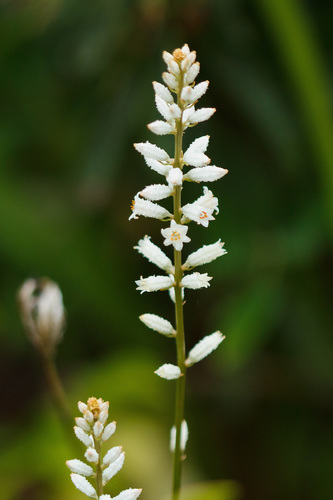Colicroot

Species information
The following is a report on progress made towards the protection and recovery of Colicroot (Aletris farinosa) in Ontario from 2007 to 2022, based on Ontario’s species-specific recovery policy. This report meets the legislative requirement for a review of progress under the Endangered Species Act, 2007 (ESA or “the Act”). Colicroot is listed as endangered on the Species at Risk in Ontario (SARO) List under the ESA.
Colicroot has been classified as a species at risk since 2004. It was originally classified as a threatened species and was listed as such under the ESA when it came into force in June 2008.
The species was re-classified as an endangered species in June 2016.
Colicroot has been protected from being killed, harmed, harassed, captured or taken since 2008.
In addition, the habitat of Colicroot has been protected from being damaged or destroyed since 2013.
The species-specific recovery policy for Colicroot, known as the Government Response Statement (GRS) was published in 2018 and includes the government’s recovery goal for the species and the actions and priorities it intends to lead or support to help achieve that goal. The GRS considers science advice provided in the recovery strategy (published in 2017), such as species biology, habitat needs, threats to survival, knowledge gaps and approaches to recovery, when developing recovery actions for the species. As legislated in the Act, the purpose of this Review is to report on progress made towards implementing the protection and recovery actions in the GRS. The review can also help identify opportunities to adjust and adapt the implementation of protection and recovery actions to achieve the recovery goal for the species.
Further information about Colicroot, including the threats that it faces, and actions being taken to help protect and recover this species is available on the Government of Ontario webpage for Colicroot. A summary on the progress towards the protection and recovery of Colicroot and an annual update on the broader species at risk program (i.e. the Introduction to the 2023 Review of Progress report) is available on the Review of Progress towards the Protection and Recovery of Ontario’s Species at Risk webpage.
Snapshot: Progress towards the protection and recovery of Colicroot
Progress towards meeting the recovery goal
- The recovery goal in the Government Response Statement (GRS) for Colicroot in Ontario is to “maintain the Ontario distribution and, where feasible, support increases in abundance of existing populations. The government supports investigating the feasibility of augmenting existing sites deemed to be non-viable without additional recovery efforts.”
- Progress has been made towards implementing all of the government-led actions. Progress has been made towards implementing most of the government-supported recovery objectives and a majority of the associated actions. Examples of progress include:
- Maintaining, enhancing, and creating acres of Colicroot habitat across various locations
- Minimizing threats by conducting prescribed burns and invasive species removal in Colicroot habitat
- Collaborating with stakeholders, landowners, and land managers to enhance capacity to protect species at risk including Colicroot, develop Best Management Practices, and deliver technical training and outreach on stewardship actions and property management
- In alignment with the GRS, further work is required to:
- Increase knowledge of Colicroot biology, population dynamics, habitat requirements and further refine current recovery techniques
- Encourage the recording, sharing, and transfer of Traditional Ecological Knowledge to increase knowledge of the species historically and currently, and support future recovery efforts
Occurrences and distribution:
- Fourteen populations of Colicroot have been documented in Southwestern Ontario. Currently, five of these populations are extant, eight populations are extirpated, and one population failed to be found. No populations of Colicroot have been newly identified since 2008.
- Since 2008, the Natural Heritage Information Centre (NHIC) has received 259 records of the species based on observations made between 1892 and 2022.
Government-supported stewardship projects:
- Through the Species at Risk Stewardship Program, the Government of Ontario has supported 11 projects (by providing $502,313 in funding) designed to contribute to the protection and recovery of multiple species at risk, including Colicroot.
- The government’s support helped its stewardship partners to involve 226 individuals who volunteered 2,582 hours of their time towards protection and recovery activities for multiple species at risk, including Colicroot. The estimated value of these voluntary contributions, as well as additional funding and in-kind support, is $487,310.
- Stewardship partners reported that through their actions 139.50 hectares of habitat were enhanced for Colicroot and other species at risk that inhabit the same ecosystem.
- Stewardship partners reported providing outreach on multiple species at risk, including Colicroot, to 1,366 individuals.
Supporting human activities while ensuring appropriate support for species recovery:
- The Government of Ontario has issued three permits for this species: two ‘protection or recovery’ permits were issued under clause 17(2)(b), and one ‘social or economic benefit’ permit was issued under clause 17(2)(d) of the ESA.
- Thirty-six activities have been registered for the species. The activities were registered under ‘threats to human health and safety, not imminent’ (section 23.18); ‘species protection, recovery activities’ (section 23.17); ‘drainage works’ (section 23.9) and ‘ecosystem protection’ (section 23.11) under Ontario Regulation 242/08 of the ESA.
Reporting on the progress towards the protection and recovery of Colicroot
Recovery Goal
The government’s goal for the recovery of Colicroot is to maintain the Ontario distribution and, where feasible, support increases in abundance of existing populations. The government supports investigating the feasibility of augmenting existing sites deemed to be non-viable without additional recovery efforts.
The implementation of government-led and government-supported actions demonstrates progress towards reaching the desired objectives and the recovery goal set out in the GRS.
Progress towards implementing government-led actions
Progress has been made towards all government-led actions identified in the GRS. Common actions for the government to lead as it works towards achieving a species’ recovery goal include:
- Continue to manage habitat in protected areas to maintain or improve suitability for the species using appropriate methods (e.g., removing woody vegetation, prescribed burning).
- Continue to implement the Ontario Invasive Species Strategic Plan to address the invasive species (e.g., Common Buckthorn) that threaten Colicroot.
- Continue to implement Ontario’s Invasive Species Act to address the invasive species identified in the Act (e.g., Phragmites) that threaten Colicroot by restricting the importation, deposition, release, breeding/growing, buying, selling, leasing or trading of Phragmites or European Common Reed.
- Educate other agencies and authorities involved in planning and environmental assessment processes on the protection requirements under the ESA.
- Encourage the submission of Colicroot data to the Ministry’s central repository at the Natural Heritage Information Centre.
- Undertake communications and outreach to increase public awareness of species at risk in Ontario.
- Continue to protect Colicroot and its habitat through the ESA.
- Support conservation, agency, municipal and industry partners, and Indigenous communities and organizations to undertake activities to protect and recover Colicroot. Support will be provided where appropriate through funding, agreements, permits (including conditions) and/or advisory services.
- Encourage collaboration, and establish and communicate annual priority actions for government support in order to reduce duplication of efforts.
Key progress made towards implementing these actions is described in the following sections.
The Government of Ontario continues to take action to advance the management of European Common Reed, also known as Invasive Phragmites, by working with partners to identify innovative solutions to control this invasive plant. For example, the Ministry of Natural Resources and Forestry (MNRF) provided funding to support the development of A Strategic Framework for Coordinated Management of Invasive Phragmites in Ontario by the Green Shovels Collaborative. MNRF is also investigating potential biological control agents for Invasive Phragmites with federal partners, the University of Toronto, and Ducks Unlimited Canada.
Ontario Parks has generally undertaken annual prescribed burns within a few provincial parks that support extant or historical populations of Colicroot. In Ojibway Prairie Provincial Park, annual woody vegetation removal has taken place to maintain the tallgrass prairie. In recent years, Ontario Parks has partnered with research groups to remove stands of Invasive Phragmites in the park.
Ontario’s Invasive Species Act
The GRS for Colicroot indicates that invasive species (e.g., Invasive Phragmites, Scots Pine, Autumn Olive, Multiflora Rose, Black Locust, Sweet Clover, and Common Buckthorn) pose a threat to the survival and recovery of the species in Ontario. The Ontario Invasive Species Strategic Plan, 2012 and the Invasive Species Act, 2015 provide the policy and legislative framework to prevent new invaders from arriving and surviving in Ontario, to slow and where possible reverse the spread of existing invasive species, and to reduce the harmful impacts of existing invasive species, including impacts on species at risk.
This framework may support the implementation of actions to reduce the threats from invasive species. For example, to prevent its further spread and introduction, Invasive Phragmites was listed as a restricted species under the Invasive Species Act in 2016. It is now illegal to import, deposit, release, breed/grow, buy, sell, lease or trade this restricted invasive species in Ontario. It is also illegal to bring a restricted species into a provincial park or conservation reserve and to possess, transport, deposit or release them in these protected areas.
Guides and resources
The Government of Ontario recently supported the development of Best Management Practices for Invasive Common Buckthorn (2012) (PDF) by the Ontario Invasive Plant Council to provide guidance for managing this invasive plant species.
Occurrences and distribution
Fourteen populations
It is possible that there are observations of Colicroot that have not been submitted to the government. Encouraging the submission of observations of this species is included in the GRS as a government-led action. Submission of species observations increases our knowledge of where they occur and can play an important role in assessing the viability of species populations.
Everyone is encouraged, or may be required by an authorization or approval to submit observations of Colicroot, and any other species at risk observed, to the NHIC for incorporation into the provincial record of observations.
-
259observations of this species were submitted to the NHIC since 2008.
Government-supported stewardship projects
An important government-led action in the GRS for Colicroot is to support partners to undertake activities to protect and recover the species. Through the Species at Risk Stewardship Program the government has supported 11 projects ($502,313) designed to contribute to the protection and recovery of multiple species at risk, including Colicroot
Stewardship partners reported that provincial funding helped them to secure in-kind support by involving 226 individuals who volunteered 2,582 hours of their time towards protection and recovery activities for multiple species at risk, including Colicroot, which has an estimated value of $83,532. Partners also reported that through both their efforts and the efforts of their volunteers to implement GRS, they were successful in enhancing 139.50 hectares of habitat that will benefit multiple species at risk, including Colicroot. In addition, stewardship partners reported providing ecosystem-based outreach on multiple species, including Colicroot, to 1,366 individuals.
The remainder of this section highlights two projects supported through the Species at Risk Stewardship Program as well as the corresponding government-supported recovery actions for the species.
A 2008 project by Tallgrass Ontario used a Geographic Information System (GIS) to assemble a comprehensive map of tallgrass ecosystems in Ontario, with the objective to help landowners, land managers, and planners identify priority species, habitats, and landscapes of management concern. During fieldwork, in addition to mapping the ecosystems, researchers noted coordinates of provincially rare tallgrass ecosystem species. Twenty Colicroot specimens were located during these efforts. The project implemented three government-supported recovery actions: conducting surveys where the continued presence of the species is unknown (Action No. 3); researching the species’ habitat requirements to inform recovery efforts (Action No. 5); and promoting local awareness about Colicroot and co-occurring species at risk among land owners, land managers and interested Indigenous communities and organizations, and promoting community involvement by sharing information on the species’ habitat requirements and actions that can be taken to reduce threats to the species and its habitat (Action No. 9). Each physiographic area was analysed for soils, land cover, road/housing density, protected areas, ownerships conservation risk index, threats, and recommended actions. The analysis produced a recovery area boundary, which has helped inform continued recovery efforts.
A 2015 project by Tallgrass Ontario focused on habitat management for multiple species at risk, including Colicroot. The project implemented two government-supported recovery actions: developing and implementing best management practices in collaboration with landowners, land managers, municipalities, and interested Indigenous communities and organizations, to improve habitat suitability and minimize threats to Colicroot and its habitat, including managing vegetation to improve habitat quality (Action No. 1) and conducting surveys where the continued presence of the species is unknown (Action No. 3). At Ojibway Park and Tallgrass Prairie Heritage Park, the project team conducted surveys of at-risk species, including Colicroot, Slender Bush-clover, and several snake species. In addition, prairie habitat was enhanced through a prescribed burn, invasive vegetation removal, and herbicide application to encroaching woody vegetation.
-
 11
11projects including Colicroot
-
 $502,313
$502,313for projects that included Colicroot
-
 $487,310
$487,310in additional funding and in-kind support
-
 226
226volunteers
-
 2,582
2,582volunteer hours
-
 1,366
1,366people received outreach
-
 140
140hectares of habitat enhanced
Supporting human activities while ensuring appropriate support for species recovery
Supporting partners through authorizations and their associated conditions is an important government-led action.
Three permits have been issued for Colicroot since the species has been protected under the ESA: two ‘protection or recovery’ (17(2)(b)) permits and one ‘social or economic benefit’ (17(2)(d)) permit.
‘Protection or recovery’ permits are issued if the purpose of the activity is to assist in the protection or recovery of a species at risk. Of the two ‘protection or recovery’ permits, one was issued exclusively for Colicroot, and the other was issued for multiple species, including Colicroot. These permits enabled organizations to undertake activities such as Colicroot augmentation and habitat enhancement/creation.
One ‘social and economic benefit’ (17(2)(d)) permit was issued for multiple species, including Colicroot, as part of the authorization process for the construction of enhanced international border crossing infrastructure between Windsor, Ontario, and Detroit, Michigan.
Although the main purpose of an activity authorized by a 17(2)(d) permit is not to assist in the protection or recovery of the species, the Minister must be of the opinion that the activity will result in a significant social or economic benefit to Ontario. The Minister must also be of the opinion that the activity will not jeopardize the survival or recovery of the species in Ontario, that reasonable alternatives have been considered, and that reasonable steps to minimize adverse effects on the individual members of the species are required by the conditions of the permit.
In this permit, general conditions to minimize adverse effects on the species included:
- Providing all workers on the site with a fact sheet identifying each of the species at risk named in the permit and species-specific guidance on appropriate actions to be taken whenever a member of these species is encountered
- Ensuring that before any person begins carrying out any mitigation or monitoring activities authorized by the permit, the person receives training on relevant species at risk by persons authorized by the government
The permit also included more detailed conditions such as:
- Developing and implementing an approved Colicroot restoration and management plan that provides detailed information with respect to restoration activities, such as:
- seed collection and propagation techniques
- seed distribution and planting techniques
- plug planting and transplanting techniques and management
- habitat restoration, enhancement and creation techniques for each Final Restoration Site
- Conducting a detailed site assessment to determine which sites are suitable for receiving planted and transplanted Colicroot individuals
- Creating, enhancing, or restoring a minimum of two hectares of tallgrass prairie, focusing on lands directly adjacent to existing Colicroot populations to serve as natural Colicroot population expansion areas
Registration information
Thirty-six activities that may affect Colicroot or its habitat have been registered for the purposes of Ontario Regulation 242/08: ‘General’under the ESA. Eighteen activities were registered under ‘threats to human health and safety, not imminent’ (section 23.18); 10 activities were registered under ‘species protection, recovery activities’ (section 23.17); six activities were registered under ‘drainage works’ (section 23.9); and two activities were registered under ‘ecosystem protection’ (section 23.11). These registrations require the registrant to comply with all conditions of the regulation, such as:
- giving the Ministry of Environment, Conservation and Parks notice of the activity before it commences
- having a mitigation plan prepared by a person with expertise on Colicroot to minimize adverse effects on the species
- taking reasonable steps to minimize adverse effects of the activity on Colicroot and its habitat while carrying out the activity
-
1social or economic benefit permit
-
2protection or recovery permits
-
36registrations
Progress towards implementing government-supported actions
Government-supported actions are organized under overarching recovery objectives. Progress has been made towards achieving all the government-supported recovery objectives and implementing a majority of the associated actions identified in the GRS for Colicroot.
Objective: Maintain or improve the quality of habitat available for Colicroot, and reduce threats to the species at locations where it exists in Ontario.
- Action No. 1 (High Priority) - Develop and implement best management practices in collaboration with landowners, land managers, municipalities, and interested Indigenous communities and organizations, including Bkejwanong (Walpole Island First Nation), to improve habitat suitability and minimize threats to Colicroot and its habitat. Efforts should be made where appropriate to coordinate efforts with other species at risk plants (e.g., Dense Blazing Star) and tallgrass prairie habitat initiatives. Actions may include:
- Managing vegetation to improve habitat quality (e.g., controlling invasive species posing a direct threat, controlling native woody vegetation, and prescribed burns, as appropriate)
- Monitoring the species’ and habitat response to habitat management to inform adaptive implementation of management approaches
- Re-directing recreational activities (e.g., ATVs) through the use of signage and fencing
- Action No. 2 - As opportunities arise, support the securement of Colicroot habitat that exists on privately owned lands through existing land securement and stewardship programs.
Under this objective considerable progress has been made towards implementing all actions.
Action 1 has been implemented through six projects supported by the Species at Risk Stewardship Program, through the development or implementation of best management practices to enhance, create, or restore Colicroot habitat and to minimize threats via invasive species removal and prescribed burns.
Action 2 has been implemented through one project supported by the Species at Risk Stewardship Program, involving engagement with land owners and land managers to support the securement of Colicroot habitat through land securement and stewardship programs.
Objective: Increase knowledge of Colicroot distribution, abundance, habitat, and the significance of threats in Ontario.
- Action No. 3 (High Priority) - Develop and implement a standardized long-term monitoring program at existing locations (including restoration sites) and conduct surveys where the continued presence of the species is unknown (e.g., Turkey Point). As appropriate, the monitoring program should target multiple species at risk plants (e.g., Dense Blazing Star) and tallgrass prairie habitat. The monitoring program will build and adapt from previous efforts:
- Monitor population dynamics, health and productivity
- Assess and monitor all known threats and potential threats to populations
- Monitor the status of transplanted Colicroot plants at restored sites
Under this objective considerable progress has been made towards implementing Action No. 3.
Action No. 3 has been implemented through five projects supported by the Species at Risk Stewardship Program, where objectives included creating GIS maps of tallgrass prairie habitat, conducting an inventory of species at risk including Colicroot, monitoring known and potential threats to Colicroot populations, and monitoring the status of transplanted Colicroot plants at restored sites.
Objective: Increase local awareness of the species, its habitat requirements, and ways to minimize threats to Colicroot.
- Action No. 9 - Promote local awareness about Colicroot and co-occurring species at risk among land owners, land managers and interested Indigenous communities and organizations, including Bkejwanong (Walpole Island First Nation) and promote community involvement by sharing information on:
- How to identify the species
- The species’ habitat requirements
- Protection afforded to the species and their habitat under the ESA
- Actions that can be taken to reduce threats to the species and its habitat
Under this objective considerable progress has been made towards implementing Action No. 9.
Action No. 9 has been implemented through eight projects supported by the Species at Risk Stewardship Program, where awareness about Colicroot was promoted to land owners, land managers, and community members. In some projects, community members directly engaged in actions to enhance Colicroot’s habitat requirements and reduce threats to the species.
Summary of progress towards meeting the recovery goal
The recovery goal for Colicroot is to maintain the Ontario distribution and, where feasible, support increases in abundance of existing populations. The government supports investigating the feasibility of augmenting existing sites deemed to be non-viable without additional recovery efforts.
Effort made towards the government-led and government-supported actions has helped to make progress towards this goal. For example, there has been continued restoration efforts in Colicroot habitat. The Species at Risk Stewardship Program has also helped fund several projects to engage land owners, land managers, and community members to promote awareness about Colicroot and the actions needed for its recovery.
Recommendations
As stated in the GRS, this review of progress can be used to help identify whether adjustments to the implementation of GRS actions are needed, to achieve the protection and recovery of the species. Based on progress to date, the overall direction provided in the GRS for Colicroot, particularly the implementation of actions identified as high priority, should continue to guide protection and recovery of the species.
While there has been much focus on the progression of other actions, the following actions require additional support to aid the protection and recovery of the species:
- Action No. 4: As appropriate, encourage the recording, sharing and transfer of Traditional Ecological Knowledge, where it has been shared by communities, to increase knowledge of the species historically and currently, and support future recovery efforts. Coordinate these efforts with co-occurring species at risk (e.g., Dense Blazing Star) and tallgrass prairie habitat initiatives.
- Action No. 5 (High): Research the species’ life history characteristics and habitat requirements to inform recovery efforts, including:
- studying the effects of genetic inbreeding, seed ecology, pollinator relationships, and flowering biology
- conducting population viability analyses
- studying the relationship with mycorrhizal fungi
- studying the species’ sensitivity to edge effects and drought tolerance
- Action No. 6: Research seed bank response to habitat management to determine whether populations still exist at locations that have been extirpated due to succession.
- Action No. 7: Investigate the feasibility of augmenting Colicroot by identifying potential sites for augmentation (i.e., existing sites where the population is deemed to be non-viable) and determining if feasible and appropriate.
- Action No. 8: Evaluate the effectiveness of current augmentation techniques, including conducting research to establish a standardized method to propagate Colicroot plants from seed.
Footnotes
- footnote[1] Back to paragraph For the purposes of this report, a population is defined as an area of land and/or water on/in which an element (e.g., Colicroot) is or was present. They are comprised of one or more observations and the area has a practical conservation value as it is important to the conservation of the species. An element occurrence is the technical term used to describe this.
- footnote[2] Back to paragraph In this context, “Failed to find” means that a documented occurrence has not been found despite subsequent search effort by an experienced observer under appropriate conditions. However, the occurrence may still be confirmed at that location with additional survey effort, as suitable habitat is found there.
- footnote[3] Back to paragraph Some projects supported through the Species at Risk Stewardship Program may have required a 17(2)(b) permit in order to carry out the project. As a result, some 17(2)(b) permits indicated in this report may have been issued to authorize those projects.